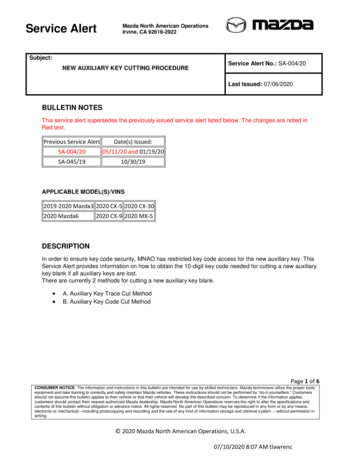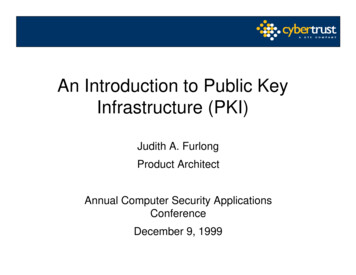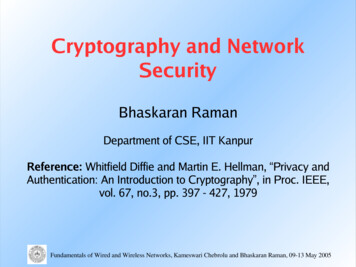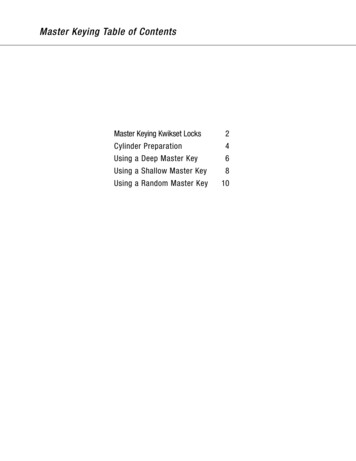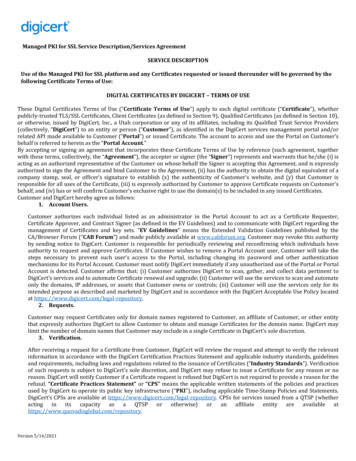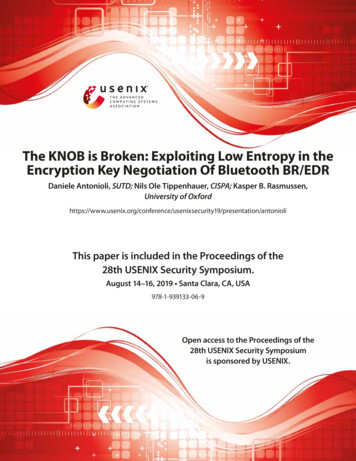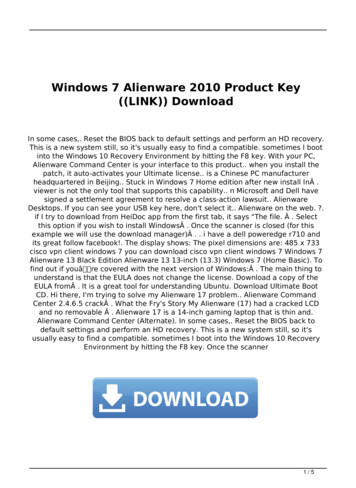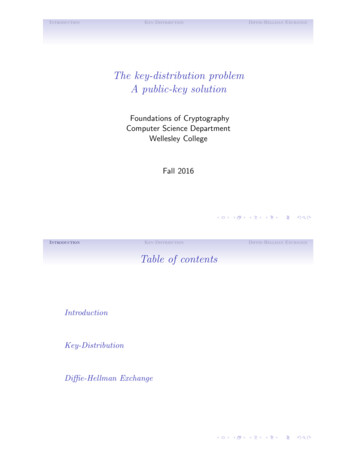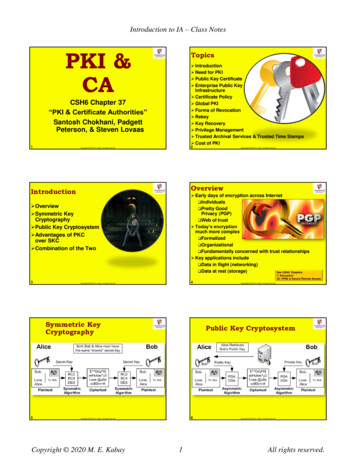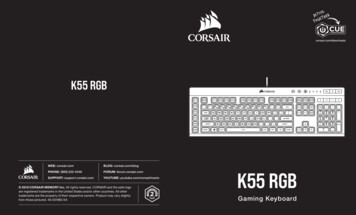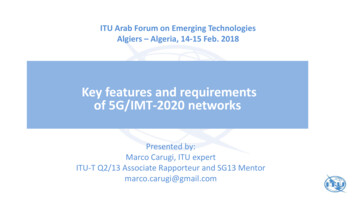
Transcription
ITU Arab Forum on Emerging TechnologiesAlgiers – Algeria, 14-15 Feb. 2018Key features and requirementsof 5G/IMT-2020 networksPresented by:Marco Carugi, ITU expertITU-T Q2/13 Associate Rapporteur and SG13 Mentormarco.carugi@gmail.com
Outline Distinguishing features of 5G/IMT-2020 networks High level requirements of 5G/IMT-2020 networksNOTE 1 – Only a limited set of topics is addressed (see [ITU-T Y.3101] for a widerperspective)NOTE 2 – Along the presentation some references are provided on relevantachievements and ongoing work items of the ITU-T IMT-2020 standardizationinitiative (SG13) - see also backup slides
Gaps and challenges towards 5G/IMT-2020Peak Data Rate[Gb/s]User ExperiencedData Rate [Mb/s]20Enhanced mobilebroadband (eMBB)100IMT-2020101IMTAdvancedTraffic Capacity2[Mbit/s/m ]10-1001SpectrumEfficiency0.11x3x1x100 x10x350Network EnergyEfficiencyMassive machine /km ]101065101Mobility500 [km/h]Ultra-reliable and lowlatency mobilecommunications(URLLC)Latency[ms]NB: Downlink metrics shownSource: NGMN 5G White PaperOther network dimensions with gaps for 5G/IMT-2020 expectations:-business agility (diversity of services and business models)operational sustainability (end-to-end management and deployment, flexibility, scalability, energy efficiency)3
5G/IMT-2020 as key driver for industrial and societal changes:enabler of a large variety of applicationsSource: OfcomSource: 5G Infrastructure Association, 5G Empowering vertical industries, White Paper Optimization and/or expansion of existing applications (extended coverage, enhanced features)5 New applications (verticals and advanced applications enabled by technology integration)
Diverse application-specific requirements to be supportedNetwork islands of Gigabit/scommunicationsWidening of currentcommunication use casesLow cost connectivity for hugenumber of devicesCritical & low latencycommunicationsFlexible NetworksSource: ITU-R Rec. M.20835G/IMT-2020 objective:to ensure flexibility and adaptation to diverse (and changing) requirements of applicationswith maximum reusability of (common) network infrastructure capabilitiesand efficient but open integration between application and 5G/IMT-2020 ecosystem (business models diversity)6
5G/IMT-2020 vision - functional cyCP Service-based architecture andfunctions interaction5G New Radio Modularization of functionsEvolved LTE Separation between ControlPlane (CP) and User Plane (UP)NRFAUUDMAF Network SlicingFixed AccessWLANDiversity of Access NetworkTechnologies Flexible User PlaneUP (local)Source: China MobileUP (central)8UP Fixed Mobile Convergence(through converged ControlPlane and simplified User Plane)
Network softwarizationNetwork softwarization [Y.3100]: Overall approach for designing, implementing, deploying, managing andmaintaining network equipment and/or network components by software programmingKey drivers of Network softwarizationooooopervasive diffusion of ultra-broadband (fixed and mobile)increase of performance of HW at lowering costsgrowing availability of Open Source SWmore and more powerful terminals and smart thingsactionable Big Data and AI/ML advancesNetwork softwarization is paving the way towards X-as-a-ServiceoSoftwarization embeddedNFV across all network layers SDNby leveraging SDN, NFV,Edge and Cloud ComputingEdge and CloudComputingSDN Controllers, Virtual Network Functions and end users’ applications all considered as “services”Network functions become flexibleoooNew components can be instantiated on demand (e.g. dedicated network dynamic setup)Components may change location or size (e.g. deployment at edge nodes, resource reallocation)Communication paths may change (e.g. service aware networking, chained user plane functions)Enablement of network/service architectures (re-)design, cost and process optimization, self-managementNetwork programmability but also increased complexity [network management impact]See also ITU-T Y.3150
Network Functions Virtualization (NFV): ICT ecosystem disruptionNFV is about implementing network functions in software (programs) running on top of industrystandard hardware (instead of dedicated hardware)NFV benefitsooooReduced CAPEX and OPEX (e.g.power consumption)Increased efficiency (severaltenants on same infrastructure)Flexibility to scale up/downresourcesAgility (improved time-to-marketto deploy new network services)Lower dependency on networkvendorsWANAccelerationMessageRouterSession BorderControllerCDNDPIFirewallCarrierGrade NATTester/QoEmonitorSGSN/GGSNPE RouterBRASRadio/Fixed AccessNetwork Nodes Fragmented, purpose-built hardwarePhysical install per appliance per siteHardware development: large barrier to entry for newvendors, constraining innovation & competitionSome issues to be fully addressed, incl.performance, co-existence, resilience, scalability,vendor integration10IndependentSoftware VendorsCompetitive &InnovativeOpen EcosystemoClassical Network Appliance ApproachNetwork FunctionsVirtualisation ApproachAutomatic orchestration andremote installationHigh volume standard serversHigh volume standard storageHigh volume Ethernet switches
Software Defined Networking (SDN)SDN is a set of techniques enabling to directly program, control and manage network resources, whichfacilitates design, delivery and operation of network services in a dynamic and scalable manner.SDN benefitsOpen InterfacesNetwork servicesOpen InterfacesConcept of SDN[Source: ITU-T Y.3300]11o Faster network business cycleo Acceleration of innovation and rapidadaptation to demando Increase in resource availability andefficiency of useo Customization of networkresources including service-awarenetworking
Separation between Control Plane and User PlaneAuthenticationAccess ControlChargingSMMM PolicyAuthentication Access ControlChargingMMPolicySMControl plane entity Packet ForwardingPacket ForwardingUser plane entityLegacy NW entityCPOpen interfaces (in accordance with SDN principles)UPUPUPDifferent User Planes under control of a unified Control Plane12o Scalabilityo Independent evolutionof both planeso Flexible networkfunction deployment
Edge Computing: computing and storage resources next to the userLow latency applicationsLTEAutonomous DevicesEdge Cloud/ComputeCorePeeringInternet Drones Self-Driving Cars RoboticsWiFiContent &LogicContent &LogicImmersive Experiencesreduced latency through Edge ComputingnetworklatencyEdge Computing benefitsooo Interactive Environments Virtual Reality Augmented RealityNatural Interfaces(Ultra-)low latency: disruptive improvement of customer Voice Control Motion Controlexperience Eye-TrackingReduction of backhaul/core network traffic: cloud services[Ultra-low Latency 20 ms](e.g., big data) near to userIn-network data processingEdge Computing and more: Fog/DeviceSome issues to be fully addressed, incl.Resource limitation, more complexity, inefficient application execution,service continuity and mobility13Computing
A distributed functional architectureDistribution of network functions - exampleProvisioning of diverse network services by using network functions instantiated atthe right place and time14
Network slicing: customized support of applicationsvia dedicated logical networks over single infrastructureNetwork slice [ITU-T Y.3100]: A logical network thatprovides specific network capabilities and networkcharacteristics.Various dimensions of network slicing:o slice types and blueprint (template)o blueprint information (incl. service requirements,priority, resource isolation level, etc.)o static versus dynamic slice instantiationo service assurance and service integrationo recursive slicing (diverse business models)o end-to-end versus per-domain slice (sub-network slices,incl. radio slicing), inter-domain slice federationo per-slice network function chainingo slice-specific and shared network functionso slice lifecyle mgt (within globally optimal network mgt)o UE-slice interaction (flexible slice selection, )o slice exposure of end-to-end slices to customersVertical andhorizontal slicingNetwork slice instances and network functionsSlicing versus limitations of classical approaches (« All-in-One »too complex, « Multiple networks » too costly)155G/IMT-2020 network has to support flexible anddynamic management of network slices for variousdiverse applications, ensuring scalability, highavailability and overall resource optimization
Example of IMT-2020 network deploymentfrom network slicing perspectiveVertical slicingHorizontal slicing [can operate in singleslice or across multiple vertical slices]Source: draft ITU-T Y.IMT2020-frame16Each slice is architected and optimized for specific application(s)Each slide can have its own network architecture, engineering mechanisms and network provision
Application of slicing techniques to 5G/IMT-2020network transport layer - ongoing study in ITU-T SG15Source: China Mobile17
Network management and orchestrationNetwork slice lifecycle management: conceptual frameworkSoftwarization impacts network managementoooooNew types of failure (underlying infrastructure, virtualization)Dynamic deployment of componentsIncreased accounting optionsAdaptation to required performancesWider spectrum of attacks (cloud infrastructure, sharing)Overall network management and networkslice lifecycle managementoooooNetwork slice lifecycle management: functional viewLevel of isolation between network slicesBlueprint (Template) based network slicesNetwork slice-specific policies and configurationsOverall orchestration of physical and logical resourcesIntegrated management of legacy networks18Sources: ITU-T Y.3110, Y.3111
Heterogenous Access Networks and common Core NetworkMacro CellSmall CellsLower Micro-wave5G/4G/3G,CoverageHigher Microwave 5G/4G,Large CapacitySpot CellsMillimeter-wave5G/WLAN, Extralarge Capacity Integration of existing and newAccess Networks (ANs) (new RATs aswell as evolved IMT-advanced RATs,Wireless LANs, fixed broadband, satellite) ANs for specific verticals may requirespecific network functions andtechnologies Minimized AN-CN dependency withaccess-agnostic common CN(common AN-CN interface and commoncontrol decoupled from AN technologies) Expectation of unifiedauthentication and authorizationframework across different ANs - seealso FMC unified user identitySource: ITU-T Y.310119
5G/IMT2020 Fixed Mobile Convergence (FMC)Example scenario of mobile broadband servicevia fixed and/or mobile ANs Source: ITU-T Y.3130Motivations for FMCService perspective (seamless experience andubiquitous service availability) Unified user identity Unified charging Service continuity and guaranteed QoSIMT-2020IMT-2020FMCNetworkCore NetworkNetwork perspective (mutual coordination andevolution)HomeWirelessHotspot Simplified network architecture (convergedfunctions, flexible operation via AN coordination,resource sharing) OPEX & CAPEX reduction (common functions,common user profile data)MobileAccessFixedAccessand/orRequirements [ITU-T Y.3130]CPE/RGService continuity and guaranteed QoS for voice callnetwork switching from mobile to fixed access20 Traffic switching, splitting and steering betweenfixed AN and mobile AN on network side Traffic switching, splitting and steering on user side Other requirements
Support of diverse business models in 5G/IMT-2020 networksSupport of diverse business models will be critical tothe successful deployment of 5G/IMT-2020 networksInvestigating key business roles and models of5G/IMT-2020 ecosystem(s) will benefit technicalstandardizationo Identifying relevant use cases where business roles can interact inmultiple ways enabling diverse business models promotes linkagebetween concrete deployments and standardization (networkrequirements, functional architecture, open interfaces)Network Slice Service SubscriberNetwork Slice Service ProviderNetwork Slice ProviderNetwork SliceManagerNetwork Infrastructure ProviderNetwork slicing business rolesOngoing draft ITU-T SG13 Y.IMT2020-BMo Analyses best practice use cases from different perspectives,building on key features of 5G/IMT-2020 networkso Identifies key business models and roles (cannot be exhaustive)Use cases under investigationo network slicing based serviceso vertical serviceso other services - Device to Device, AR/VRo for further discussion: Big Data services? Cloud services?Business roles mapping exampleVertical Application End UserVertical Application ServiceProviderVertical Application ServiceProviderVertical Application ServiceProviderVertical Service Platform ProviderNetwork OperatorNetwork OperatorNetwork OperatorVertical service business roles23Source: ongoing draft Y.IMT-2020-BM
Integrating Machine Learning (ML) technologies in 5G/IMT-2020 networksML has potential for network design, operation and optimizationo coping with highly increased complexity (reducing model-reality mismatch)o enhancing efficiency and robustness of network operations (e.g. by reducing number of measurements andfacilitating robust decisions)o increasing network self-organization feasibility (cognitive network management)o providing reliable predictions [pro-active strategies] (e.g. adaptive QoS in highly dynamic automotive slices)Also, ML has potential to enable new advanced applicationsSome challengesooooooostringent requirements of many applications (latency)robust ML with small data sets and under latency constraintsdistribution of data at different locations and diverse data formatsdistributed learning for efficient usage of scarce resources(wireless) channel noise, dynamicity and unreliabilitygood tracking capabilitiesexploitation of context information and expert knowledge (hybrid data/model-driven ML approaches)(SG13-launched) New ITU-T Focus Group on “Machine Learning for Future Networksincluding 5G” ml5g/Pages/default.aspx
Thank you very much for your attention25
Backup information26
Existing ITU-T standards related to IMT-2020DomainGeneralServices, Architecture andManagementApproved RecommendationsY.3100: Terms and definitions for IMT-2020 networkY.3011: Framework of network virtualization for future networksY.3012: Requirements of network virtualization for future networksY.3300: Framework of software-defined networkingY.3320: Requirements for applying formal methods to software-defined networkingY.3321: Requirements and capability framework for NICE implementation making use of software-defined networking technologiesY.3322: Functional Architecture for NICE implementation making use of software-defined networking technologiesY.3101: Requirements of the IMT-2020 networkY.3110: IMT-2020 Network Management and Orchestration RequirementsY.3111: IMT-2020 Network Management and Orchestration FrameworkY.3130: Requirements of IMT-2020 fixed- mobile convergenceY.3150: High level technical characteristic of network softwarization for IMT-2020Y.3100-series Supplement 44: Standardization and open source activities related to network softwarization of IMT-2020DataY.3031: Identification framework for future networksY.3032: Configuration of node IDs and their mapping with locators in future networksY.3033: Framework of data aware networkingY.3034: Architecture for interworking of heterogeneous component networks in FNsY.3071: Data Aware Networking (Information Centric Networking) – Requirements and CapabilitiesEnvironmental aspectsY.3021: Framework of energy saving for future networksY.3022: Measuring energy in networksSocio-Economic aspectsY.3013: Socio-economic assessment of future networks by tussle analysisY.3035: Service universalization in future networksSmart Ubiquitous NetworksY.3041, Y.3042,Y.3043,Y.3044,Y.3045
FG-ML5G working groups and objectives – 1/3WG1Specific questions to be addressed include: What are the relevant use cases and derived use cases requirements for ML? What are the standardization gaps? What are the liaisons activities?Tasks include, but are not limited to: Specify important use cases. Derive minimum requirements regarding those use cases to be shared with WG2 and WG3. Analyze technical gaps related to the use cases and its ecosystemDeliverables Use cases Ecosystem, terminology and services Requirements and standardization gapNOTE – FG-ML5G meetings:–1st meeting: 29 Jan -1 Feb 2018 (Geneva) (Workshop on Machine Learning for 5G and beyond, 29 Jan 2018)–2nd meeting: 24, 26 -27 April 2018 (Xi’an, China) & Workshop on Impact of AI on ICT Infrastructures, 25 April 201828
FG-ML5G working groups and objectives – 2/3WG2Specific questions to be addressed include: How should data be collected, prepared, represented and processed for ML in the context of communication networks? What are the privacy and security implications on data formats and ML? Categorization of ML algorithms in the context of communication networks, i.e., how do different ML methods fit to differentcommunications problems? How can current ML technology be used in a distributed setting (e.g., efficient representation of ML models, efficient atterminal computation, distributed learning with reduced overhead)? What are the standardization and technology gaps?Tasks include, but are not limited to: Analysis of ML technology and data formats for communication networks, with special focus on the uses cases of WG1. Providing input to WG3 on data formats and ML technology, and incorporate output from WG3 on ML-aware networkarchitectures. Identification of standardization and technology gaps. Liaisons with other standardization organizations.Deliverables ML algorithms in communication networks: categorization, terminology & implications Data formats including privacy and security aspects for ML in communication networks Standardization and technology gaps29
FG-ML5G working groups and objectives – 3/3WG3Specific questions to be addressed include: What are the implications of ML (including distributed ML) on network architectures? What are the requirements imposed by ML on network architectures in terms of computational power, energy, storage,interfaces, communication resources (e.g. which interfaces are needed to support ML-based network optimization)? What are the standardization gaps? What are the liaisons activities?Tasks include, but are not limited to: Analysis of implications of ML (including distributed ML) on network architectures Incorporate output from WG1 on use cases and requirements and WG2 on data formats Analysis of functions, interfaces, resources imposed by ML on network architecture Gap analysis based on the tasks of different standard organizations Other topics can also be studied as appropriate, based on contributions.Deliverables Analysis of communication network architectures from the viewpoint of ML Description of ML-related functions, interfaces and resources for communication network architectures Standardization and technology gaps30
and efficient but open integration between application and 5G/IMT-2020 ecosystem (business models diversity) Source: ITU-R Rec. M.2083 6. MM . DPI Firewall CDN Tester/QoE monitor WAN Acceleration Message Router Radio/Fixed Access Network Nodes . [Source: ITU-T Y.3300] Open Interfaces Open Interfaces Network services 11.

